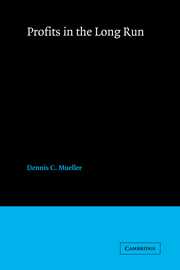Book contents
- Frontmatter
- Contents
- Acknowledgments
- 1 The persistence of firms
- 2 The persistence of profits above the norm
- 3 The persistence of market power
- 4 Profitability and market structure
- 5 The results in perspective
- 6 Profitability and the firm's own advertising, patent activity, risk, and other characteristics
- 7 Profitability and managerial control and compensation
- 8 Mergers and profitability
- 9 Mergers and market share
- 10 The threads gathered and conclusions woven
- Appendix 1 Companies studied
- Appendix 2 Industry categories
- Appendix 3 Industry matchings
- Appendix 4 Assets acquired data (Chapter 7)
- Appendix 5 Mergers and market share: samples of merging companies
- Notes
- References
- Index
6 - Profitability and the firm's own advertising, patent activity, risk, and other characteristics
Published online by Cambridge University Press: 04 May 2010
- Frontmatter
- Contents
- Acknowledgments
- 1 The persistence of firms
- 2 The persistence of profits above the norm
- 3 The persistence of market power
- 4 Profitability and market structure
- 5 The results in perspective
- 6 Profitability and the firm's own advertising, patent activity, risk, and other characteristics
- 7 Profitability and managerial control and compensation
- 8 Mergers and profitability
- 9 Mergers and market share
- 10 The threads gathered and conclusions woven
- Appendix 1 Companies studied
- Appendix 2 Industry categories
- Appendix 3 Industry matchings
- Appendix 4 Assets acquired data (Chapter 7)
- Appendix 5 Mergers and market share: samples of merging companies
- Notes
- References
- Index
Summary
The model estimated in Chapter 4 abstracts from many factors that might affect a company's profitability. This and the following two chapters introduce several firm-specific variables that might be related to corporate profitability. We begin with the company's own advertising and patent efforts. In Section B, the results regarding the firm's own advertising and patent intensities are used to appraise the seriousness of our omission of intangible capital stocks. In Section C, we explore the possibility that differences in risk across firms might account for the profit differences we observe. The relationship between profits and company growth, size, and diversification is taken up in Section D.
Profitability, firm advertising, and patent intensity
In Chapter 4, we found both industry advertising intensity and industry patent intensity to be positively related to firm profitability when included as interaction terms with market share. The rationale for including both of these variables was to proxy product differentiation, or in the case of patent intensity, product and productionfunction differentiation. But it is possible that advertising and patenting are playing some other role in the equation, or that in addition to indexing differentiation, advertising and patenting have some other role to play.
What is perhaps novel in the firm-profitability model is that advertising and patenting as industry characteristics explain firm profitability, but only when combined with firm market shares. Advertising and patenting intensity index the potential to realize high profits but do not in themselves confer high profitability.
- Type
- Chapter
- Information
- Profits in the Long Run , pp. 111 - 142Publisher: Cambridge University PressPrint publication year: 1986

